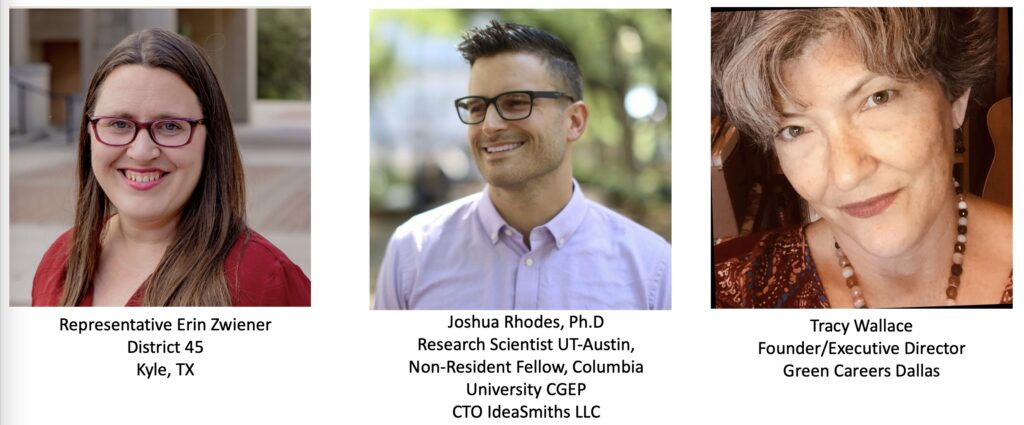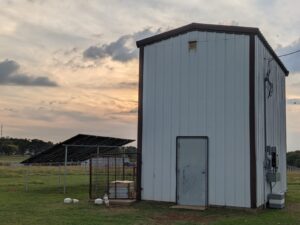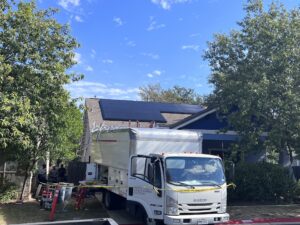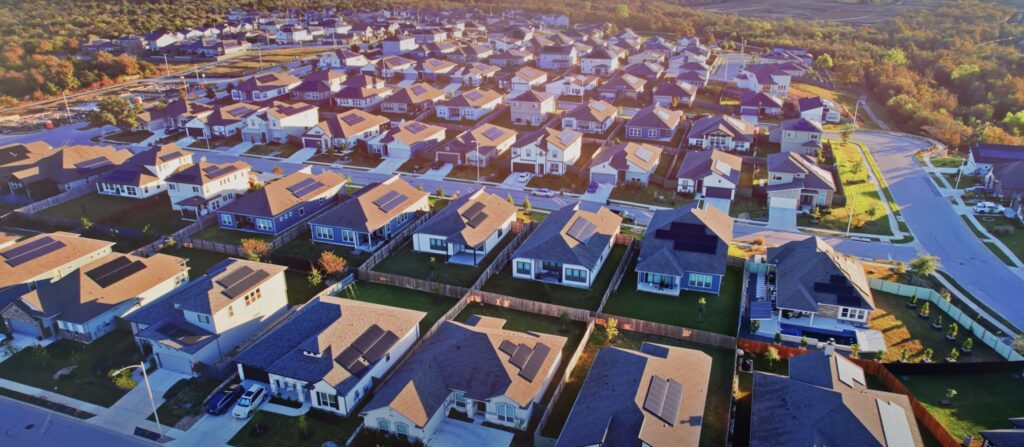Jan 24, 2023 | Txses Impact
Saturday, January 28, 2023
10am-Noon CST
via zoom
https://us02web.zoom.us/j/83359118470
As we bid 2022 adieu, we’re already in full action gear for an astonishingly busy 2023, and we’re eager to tell you what’s in the queue. Once again, in keeping with COVID-19 protocols and to make it easy for all TXSES members to attend, we’ll meet virtually. We’re honored to have this powerhouse lineup of guest presenters who will address equity, economics and policies in Texas’ clean energy space:Representative Erin Zwiener, District 45
- Tracy Wallace, Founder/Executive Director of Green Careers Dallas, a non-profit organization that provides solar installation training to residents of underserved neighborhoods in South Dallas.
- Rhodes, Ph.D., Research Scientist at UT-Austin, Non-Resident Fellow at Columbia University CGEP, CTO IdeaSmiths LLC, and former TXSES board member

We’ll also hear from each of our five regional chapters and their activities. Join us! 😎
Jan 21, 2023 | Txses Impact
The Texas Solar Energy Society (TXSES) announced the election of three new members to its board of directors, as well as the full slate of officers.
Joining TXSES’s board of directors are Louis Petrik, CEO Longhorn Solar; John Pouland, consultant; and Eiman Siddiqui, Director of State and Local Government Affairs, American Express.
“We are honored to welcome this impressive group of individuals to our board,” said TXSES Executive Director Patrice ‘Pete’ Parsons. “They bring enormous talent, insight and dedication to clean energy and are committed to helping TXSES carry out our mission as an independent, statewide not-for-profit organization accelerating the clean energy transformation through quality educational materials, outreach and policy that will lay the foundation for an equitable 100% clean energy Texas.”
The new TXSES board members are:
Louis Petrik, CEO Longhorn Solar, considers himself an accidental environmentalist. Before adding solar to the business offerings, he knew nothing about the environment or climate change. Louis has been an entrepreneur for 26 years and has run Longhorn Solar for 13 years. He is NABCEP (North American Board of Certified Energy Practitioners) certified in PV Technical Sales and PV Installation Professional. Louis has lived in Texas his entire life. He is an avid soccer supporter and follows Austin FC and Liverpool FC. Louis holds a B.A. in marketing from Southwest Texas State University.
John Pouland is currently a consultant based in Austin. He previously served as Vice President for Government Affairs and Solutions at Philips where he worked with a team across federal, state and local governments on public policy issues and procurement opportunities. Prior to joining Philips, John held a similar position at Siemens where he helped start their public sector business development program. He served as Regional Administrator of the Southwest for the US GSA during the Clinton administration and was Executive Director of the Texas General Services Commission under then Governor Ann Richards. John began his career as an attorney in private practice in Dallas. He received his J.D. from the University of Houston, and his B.A. from the University of Texas.
Eiman Siddiqui is a legislative and public policy professional with 8+ years of experience in state legislative politics. Currently, he is the Director of State and Local Government Affairs for American Express, responsible for policy and legislation in all 50 states. Previously, Eiman was a lobbyist with Davis Kaufman where he represented more than 25 clients including a solar generation company with major investments located throughout Texas. Before joining the private sector, Eiman was a legislative staffer for three Texas House of Representatives members serving as Chief of Staff, Committee Policy Director, and Capitol Director. His broad knowledge of policy includes experience in financial services, energy, insurance, and healthcare. He is also well-versed in policy impacting land use, technology, and taxation.
With the election of Petrik, Pouland and Siddiqui, TXSES’s board includes Chair Dr. Ariane L. Beck, Research Fellow, LBJ School of Public Affairs/University of Texas at Austin; Vice Chair Louis Petrik, Longhorn Solar; Secretary Laura Doll, long time public and private energy expert; and Treasurer Dub Taylor, WDT Consulting LLC; Ramsey Cripe, senior consultant at Schneider Engineering; Amy Heart, vice president of public policy at Sunrun; Karl Rábago, Rábago Energy LLC; Kenneth Thompson, director of the All American Mentoring Project.
According to TXSES by-laws, each TXSES chapter has a seat on the TXSES board. The five TXSES chapter representatives are: Mark Witte, North Texas Renewable Energy Group; Theresa Hoesl, Houston Renewable Energy Group; Leslie Libby, Solar Austin; Kaylyn Randolph, Build San Antonio Green; and Shelby Ruff, Eco El Paso.
Jan 2, 2023 | Txses Impact
This month’s Platinum Business Member profile is Nicholas Sprunck, owner/CEO of Texas Solar Cowboys, solar installer in the DFW Metroplex.
TXSES: Texas Solar Cowboys…how did this name come about?
TS: As a native Texan, I was looking for a name that embodied the spirit of Texas. What better way to represent Texas than the cowboy ideal? Our team includes my younger sister and two brothers-in-law. Our lead installer brought two family members along. And we also have close friends, both new and existing helping us out. I’m so fortunate to work alongside quality, hardworking folks who bring out the best in me. There’s a lot of love and hard work that happens here at Solar Cowboys.
TXSES: How did you and solar get connected?
TS: As the son of a master electrician, I’ve been involved in electrical work since I was 12. I started my first electrical contractor business when I was 25. About two years ago, I found my niche in the electrical industry once I found solar. I started Solar Cowboys when I was 32. What started out as just another type of electrical work has ended up becoming a new-found passion.
TXSES: I’m guessing you’re busy. Are you residential or commercial installers, or both?
TS: Yes, we’re busy, looking to grow and take on more work! We’re first and foremost a residential solar installer. We’ve done a few commercial installations and see this as a growing market. We’d love to take on more commercial projects.

Houston – 12.8KW – Installed December 2022
TXSES: Can you get hardware?
TS: Yes. We’re well connected through Greentech Renewables and materials allocated to us.
TXSES: How long does it take to install systems? Are customers adding batteries to their systems?
TS: We’re south of 45-days from contract signing to PTO (permission to operate) in most jurisdictions. That’s when the system is fully interconnected. We’ve definitely seen an increase in batteries. We proudly install Homegrid batteries with Sol-ark inverters. We find this to be a very cost effective, high-producing battery/panel combination.
TXSES: How was business in 2022, and how is 2023 shaping up? Are you already seeing an increase in business due to the recent passage of the IRA (Inflation Reduction Act)? 100%; will see uptick especially for businesses. Will know more in early Spring if sales folks see an uptick.
TS: 100%! I suspect we’ll see an uptick for businesses. Our sales team will know more in early Spring. But we’ve had tremendous growth in 2022. We went from a labor-only subcontractor to an EPC (engineering, procurement, construction) business. We moved into a new office/warehouse and are so very thankful for all that we’ve been able to do. We hope this trend continues in 2023 and eager to help as many people as possible make the switch to solar.
TXSES: What are your current workforce needs? Installers? Sales?

Cleburne – 3.6KW ground mount with .8KWh Homegrid battery on Sol-ark inverter – Installed October 2022
TS: SALES!! We’ve got a quality installation and post-sale team. We’re looking for third-party sales organizations that need a high-quality EPC firm with fast, quality installation times.
TXSES: Give me a job description and we’ll post it on the jobs page on the TXSES website! What have been some of the biggest challenges you’ve encountered?
TS: Unquestionably financing. As interest rates have risen, we’ve had to reassess our financing strategies.
TXSES: What’s surprised you the most about this work?
TS: The diversity in customers: red, blue, tree huggers, oil barons, or anyone trying to save money or to retain power during a power outage. Solar is a real smart solution for all of us.
TXSES: One last thing: did you see that Dallas County is shifting to renewable energy for all of its 55 buildings? Might be some RFPs in the queue. Thanks for the conversation, Nicholas, and for your investment in TXSES. Here’s to a sunny 2023!
For more information, contact Nicholas Sprunck or visit Texas Solar Cowboys.
Oct 31, 2022 | News
With the whopping amount of solar PV adorning rooftops since the 2021 Snowpocalypse, our business members tell us they’ve never been so busy. It’s clear: homeowners are keen on having solar on their roofs and taking advantage of the value that the system adds to their home while they live in it and when they sell it.
Carrie York, Austin real estate broker, is one of those recent solar rooftop homeowners. “After the Snowpocalypse, I decided to go solar,” she said. “I’d wanted to lessen my carbon footprint for some time but losing confidence in our grid was the catalyst.”

Credit: Carrie York
A recent Federal Energy Regulatory Commission (FERC) assessment states that the Texas grid remains almost as vulnerable to extreme winter weather as it was back in February 2021, despite the Texas Public Utility Commission’s assertion that the grid is more reliable than ever.
Although York has been a realtor in Austin for more than three decades, she’s closed only a handful of solar homes. Despite a GREEN designation for REALTORS® which offers a high-performing homes certification, York thinks that few agents really understand the value of rooftop systems, although that might be changing with consumer behavior, much like York.
Mathew Venneman, former mortgage advisor and now with Freedom Solar, concurs with York.
“After speaking with realtors, I found that many of them lacked general knowledge of how solar works or had little to no understanding of what solar can do for their clients and communities. I’m here to change that,” Venneman said. Incidentally, Freedom Solar installed a 100kW rooftop solar system at the Austin Board of Realtor’s headquarters in 2014.
On-line real estate marketplace Zillow gives solar thumbs-up for comfort, livability and utility savings. In 2019, Zillow researchers found that solar homes sold for 4.1% more on average than comparable homes without solar.
“It all depends on how it’s presented to clients,” says Venneman. “Take two homes, one without solar valued at $500K and the other with solar valued at $520K. While the mortgage on the $520K home will be more, perhaps $75-$95/month more, that cost will easily be recovered from the utility savings,” he said. “And that value is exponential…it’s going to increase as utility rates increase. Win-win-win-win.”
Texas law allows property value to go up when homeowners add wind or solar systems but doesn’t increase property taxes. “Property value added from PV systems is 100% tax-exempt,” says Venneman.
Valuing a rooftop system depends on whether the panels are leased, financed or bought outright.
According to Fannie Mae, solar panels can only be included in the home’s appraised value if they’re owned outright or financed as a home fixture so that they can’t be repossessed if the loan defaults. Being able to include panels in an appraisal and sell them as part of the property simplifies the lending process for potential buyers. Owners of solar systems are also eligible for the 30% federal tax credit.
But not everyone can afford the upfront cost of the system which can run into the tens of thousands depending on size and storage capabilities.
Systems can be financed. In fact, the 30% federal tax credit extends to financed panels as well. Typically, most mortgage lenders require the system to be paid off and transferred to the new owner upon closing to prevent the property from being devalued should the panels be repossessed by a third-party lender.
“I went with company financing and got the 30% federal tax credit,” said York. “In my opinion, lenders aren’t up to speed in this area, and they tend to go with what the appraiser says. Clearly it’s a process that needs work so the home and system realize the proper value. Now that I’m a solar homeowner, I’ll be educating buyers and lenders about the process.”
Finally, homeowners can have a solar lease or PPA (power purchase agreement) and while the easiest way to go solar, it’s the most complicated option for the seller.
In a solar lease or PPA, the homeowner buys power from a solar company, rather than buying the solar system itself. In this case, lenders take the position that because the panels are owned by a third party, appraisers are unlikely to attribute value to them.
With a standard lease, a solar provider charges fixed monthly payments (or sometimes escalating payments over the life of the lease), regardless of the amount of power you receive from the panels. By contrast, a power purchase agreement bills you a fixed rate per kWh of power produced by the panels.
Some companies will guarantee a certain amount of energy production from your panels and will refund you the difference if the system produces less. The leasing company is also responsible for the maintenance of the panels.
“I always tell homeowners that if it sounds too good to be true, then most likely it is too good to be true,” said Venneman. “If a solar company is offering 20-year leasing terms and has been in business for less than five years, it’s probably best to go a different route.”
With his mortgage background, Venneman offers a free solar 101 training for realtors and mortgage bankers. “No other asset…not a pool, kitchen or bathroom upgrade will give your home the kind of monthly dividend that a solar roof will give you,” said Venneman. “We’re changing the way Texans get their power!”
Resources:
PV Value Photovoltaic Energy Valuation Model: Online tool to calculate the lifetime value of PV panels
Pearl National Home Certification: Third party certification for high-performing homes
National Association of REALTORS GREEN designation
Appraising Properties with Solar Panels, Fannie Mae 2020 [PDF]
Oct 30, 2022 | News
On a recent Saturday afternoon, I took a drive to Whispering Valley to see for myself what a 2,000-acre planned community of sustainable design and innovation looks like. Located east of SH-130 Tollway on FM 973, Whispering Valley is seven minutes from Tesla’s Gigafactory, 12 minutes from Austin Bergstrom Airport and 25 minutes from downtown Austin. Once built out, Whisper Valley will include 5,000 single-family and 2,500 multi-family homes, retail space, restaurants, office parks, entertainment venues, two schools and a 600-acre park.

Whisper Valley is developed by Taurus Investment Holdings and Shell New Energies through its EcoSmart Solution, a green energy services provider that designs and delivers geothermal and other distributed energy resources infrastructures. According to its website: We seek to enable developers and builders of large-scale new construction neighborhoods to create energy-efficient communities and homes and provide new homeowners with affordable, comfortable, and sustainable living.
Currently, Whisper Valley is the largest sustainable development in the US to use geothermal power for all its residences and commercial buildings. In addition to the geothermal network, Whisper Valley homes and commercial buildings feature rooftop solar, EnergyStar rated appliances, smart home technology like NEST thermostats and Sense energy monitoring, smart materials use, equity, community and resilience. In addition, all homes are pre-wired for Level 2 electric vehicle charging. Thanks to the Inflation Reduction Act of 2022, homeowners can take advantage of the 30% federal tax credit for their rooftop solar systems through 2032.
It’s won a slew of awards for its innovation in sustainable design and development from the Home Builders Association of Greater Austin, the Austin Green Awards, and the Austin Business Journal.
What’s it like to live at Whisper Valley? I caught up with two of its current residents who have been living in the community for the past year.
“We love it here,” said structural design engineer, Eric Feuge. “We’re leasing for a couple of years until Phase 6 in Village 1 is complete. Then we’ll buy.”
Feuge and husband Ben Miller have been wowed by the energy efficient features in the 1,900 square foot home.
“What’s so astonishing to us is our utility bills,” said Feuge. “Before living here, we lived in a 600 square-foot apartment in Austin and our utility bills here are exactly the same as that apartment! That says volumes about the kind of energy efficiency benefits at this home compared to what we didn’t have at the apartment.”
As a structural engineer, Fegue understands the philosophy of building fast versus building right. “There are always construction issues in large, planned communities,” he said. “It’s important to do it right the first time.”
What’s surprised Fegue and Miller the most about living at Whisper Valley is how quiet it is outdoors. “Since there aren’t any outside HVAC units cycling off and on, it’s amazingly quiet in the neighborhood,” he said. “We have exactly what we’re looking for.”





